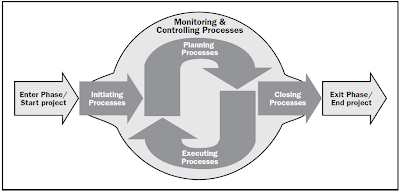Recently wrote a post saying that Agile is about Adaptive Actions, not Corrective Actions or Preventive Actions. It is published by the PMHut editorial team.
Some excerpts from the post:
. . . Adaptive Life Cycle, as noted by PMBOK, is also known as Change Driven or Agile methods. In Adaptive methods respond to high levels of change and ongoing stakeholder involvement. Due to very short iteration length for Adaptive Methods and constantly being able to respond to the change, the actions taken becomes Adaptive Actions. Actions are no more Corrective Actions . . .Let me elaborate a bit more on it. PMBOK talks of Integration Management knowledge area. To have the correct perspective, Integration management is the umbrella knowledge area encompassing all other knowledge areas. The key process areas to be looks in are:
1. Develop Project Management Plan (Initiating Process Group/PG)
2. Direct and Management Project Execution or Work as in 5th Edition (Execution Process Group)
3. Monitor and Control Project Work (Monitoring and Controlling Process Group)
4. Perform Integrated Change Control (Monitoring and Controlling Process Group)
As a project manager, along with planning, the areas which you would be looking for are Execution and Monitoring/Controlling. In Direct & Management Project Work/Execution, Monitor & Control Project Work and Perform Integrated Change Control various forms of Change Requests loom large and used frequently.
Change Request is a request to change which can come from any knowledge area - Scope, Time, Cost, Quality, Risk, Procurement et al. In both 4th and 5th edition of PMBOK this is used and it encompasses Corrective Actions and Preventive Actions. If you are familiar with PMBOK, you would know that there are concepts of Approved Change Requests, Rejected Change Requests (now streamlined in 5th edition). However, with the introduction of Adaptive Life Cycle, the concept of Change Request has remained same! Hence the conclusion as:
. . . PMBOK has not explicitly mentioned Adaptive Action anywhere, but as it has introduced Agile concepts from 5th edition onward. It has also emphasized on Adaptive Life Cycle. Hence, Adaptive Action will be a right addition to PMBOK by PMI.Complete post of the article is here.

